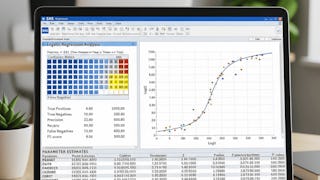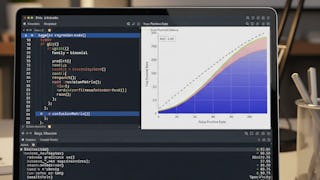This course covers predictive modeling using SAS/STAT software with emphasis on the LOGISTIC procedure. This course also discusses selecting variables and interactions, recoding categorical variables based on the smooth weight of evidence, assessing models, treating missing values, and using efficiency techniques for massive data sets. You learn to use logistic regression to model an individual's behavior as a function of known inputs, create effect plots and odds ratio plots, handle missing data values, and tackle multicollinearity in your predictors. You also learn to assess model performance and compare models.


Predictive Modeling with Logistic Regression using SAS
本课程是 SAS Statistical Business Analyst 专业证书 的一部分

位教师:Marc Huber
8,166 人已注册
包含在 中
了解顶级公司的员工如何掌握热门技能

积累 Data Analysis 领域的专业知识
- 向行业专家学习新概念
- 获得对主题或工具的基础理解
- 通过实践项目培养工作相关技能
- 通过 SAS 获得可共享的职业证书

该课程共有7个模块
涵盖的内容
1个视频7篇阅读材料
In this module, you review the fundamentals of predictive modeling. Then you explore the business scenario data that is used throughout the course. Finally, you learn about common analytical challenges that you might encounter as a modeler.
涵盖的内容
15个视频1篇阅读材料6个作业
In this module, you investigate the concepts behind the logistic regression model. Then you learn to use the LOGISTIC procedure to fit a logistic regression model. Finally, you learn how to score new cases and adjust the model for oversampling.
涵盖的内容
18个视频1篇阅读材料4个作业
In this module, you learn how to deal with common problems with your predictor variables such as missing values, categorical predictors with many levels, a high number of redundant predictors, and nonlinear relationships with the response variable.
涵盖的内容
26个视频9个作业
In this module, you learn how to select the most predictive variables to use in your model.
涵盖的内容
23个视频1篇阅读材料12个作业
In this module, you learn how to assess the performance of your model and how to determine allocation rules that maximize profit. Finally, you learn how to generate a family of increasingly complex predictive models and how to select the best model.
涵盖的内容
30个视频1篇阅读材料9个作业
涵盖的内容
1篇阅读材料1个应用程序项目
获得职业证书
将此证书添加到您的 LinkedIn 个人资料、简历或履历中。在社交媒体和绩效考核中分享。
位教师

提供方
从 Data Analysis 浏览更多内容
人们为什么选择 Coursera 来帮助自己实现职业发展




学生评论
63 条评论
- 5 stars
79.36%
- 4 stars
14.28%
- 3 stars
0%
- 2 stars
3.17%
- 1 star
3.17%
显示 3/63 个
已于 Apr 10, 2021审阅
Great training sets of problems. Good guidance & teaching.
已于 Jun 14, 2021审阅
Thank you so much to the instructor, Michael J Patetta for teaching this course!
常见问题
To access the course materials, assignments and to earn a Certificate, you will need to purchase the Certificate experience when you enroll in a course. You can try a Free Trial instead, or apply for Financial Aid. The course may offer 'Full Course, No Certificate' instead. This option lets you see all course materials, submit required assessments, and get a final grade. This also means that you will not be able to purchase a Certificate experience.
When you enroll in the course, you get access to all of the courses in the Certificate, and you earn a certificate when you complete the work. Your electronic Certificate will be added to your Accomplishments page - from there, you can print your Certificate or add it to your LinkedIn profile.
更多问题
提供助学金,








